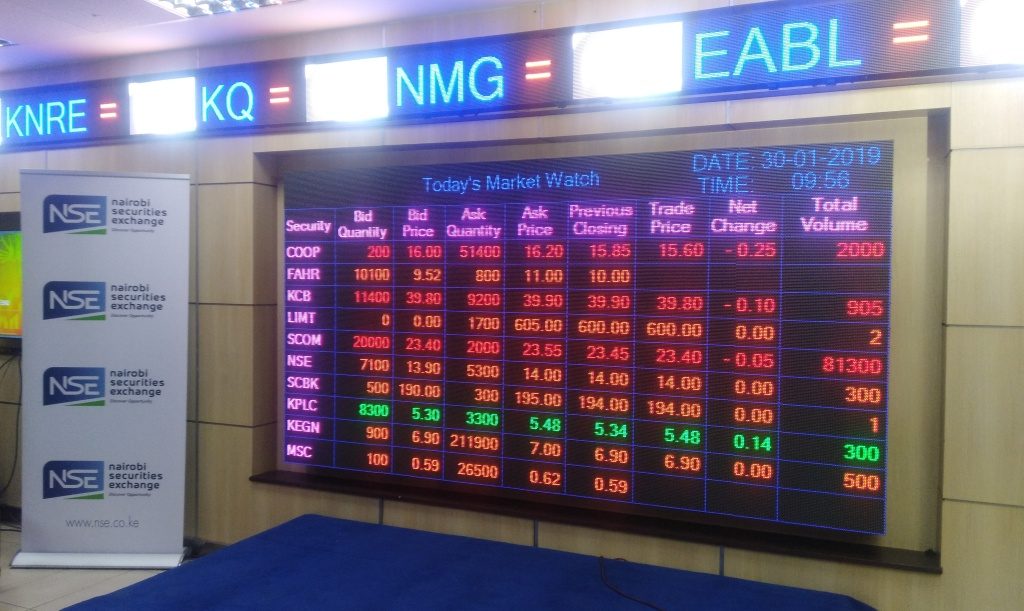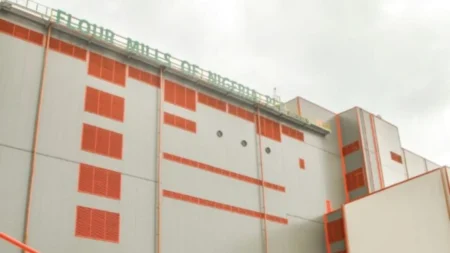Kenya’s capital markets performed dismally in the second quarter of the year, latest data shows, despite political stability and growing interest from foreign-based investors.
The Capital Markets Authority (CMA) report for the quarter ended June 2019 shows secondary equities market registered slow activity during the review period.
Equity turnover for Q2.2019 stood at Ksh32.89 billion (US$316.3million), compared to Ksh45.25 billion(US$435.1million ) registered in the previous quarter; a 27.31 per cent decrease.
Similarly, market capitalization recorded a 3.46 per cent decrease to Ksh2.278 trillion (US$21.9billion) from Ksh2.360 trillion(US$22.7billion)in Q1. 2019.
READ ALSO:NSE dips as 2018 ends on a bear market territory
Traded volumes followed the same trend, falling by 3.46 per cent to 1.39 billion during the period under review.
Other composite indicators such as the NSE All Share and NSE 20 Shares indices likewise recorded decreases of 5.11 per cent and 7.51 per cent closing the quarter at 149.61 points and 2,633.32 points respectively.
However, secondary bonds market resurged during the quarter as turnover increased by 24.81 per cent to Ksh201.71 billion (US$1.9billion) compared to Ksh161.61 billion(US$ 1.6billion) traded in Q1. 2019, indicative of the shift by investors from the equities market to the bond market as they sought to maximize on their portfolio returns.
“The reforms in the government bond market, also pronounced in budget speech, are expected to enhance transparency and predictability in the issuance and trading process for government securities; a move that will subsequently attract both domestic and foreign investors to the capital markets space,” CMA Director, Regulatory Policy and Strategy Luke Ombara said.
“Notwithstanding the mixed performance of the secondary markets, outlook for the second half of the year remains bright in the advent of positive policy incentives, the roll-out of the derivatives markets ,enhanced enforcement measures, as well as other market deepening and product uptake initiatives that are under implementation,” Ombara added.
READ:NSE gets green light for Derivatives Market
Treasury bonds
In the primary treasury bonds market, quarterly analysis indicates that during Q2. 2019, six (6) treasury bonds were issued.
In issuing these bonds, the government sought to raise Ksh140 billion (US$1.3billion), but received subscriptions worth Ksh242.1 billion(US$2.3billion). In the end, however, it accepted to issue bonds worth Ksh157.82 billion (US$1.52billion), indicating a 65.20 per cent acceptance rate.
Derivatives
Derivatives Market Launched in Kenya on May 29, 2019, after CMA granted approval to Nairobi Securities Exchange (NSE) to launch and operate the Derivatives Exchange Market pursuant to the Capital Markets Act and the Capital Markets (Derivatives Markets) Regulations, 2015.
The approval came after successful completion of a six-month Derivatives Pilot Test Phase conducted between July and December 2018, and resolution of key issues that emanated from the test phase.
“The Derivatives Market will initially offer investors Equity Single Stock Futures (SSF) and Equity Index Futures (EIF) and later introduce other financial and commodities derivatives,” CMA notes in its report.
The Exchange will initially offer index futures contracts on the NSE25 Share Index and single futures on Safaricom Plc, Kenya Commercial Bank Group Plc, Equity Group Holdings Plc, KenGen Co. Plc, East African Breweries Ltd, British American Tobacco Kenya Plc and Bamburi Cement Ltd.
The NSE Derivatives Market (NEXT) futures started trading on July 4, 2019 with the official launch of the market conducted on Thursday, July 11, 2019.
Annual Treasury Bonds
In the treasury bonds market, during the one year period from July 2018 to June 2019 period, there were twenty three (23) bond issue offers including two (2) Infrastructure bond issuances and two (2) tap sales.
The bonds’ tenors ranged between two and 25 years. During the said period, the government sought to raise Ksh610.25 billion (US$5.87billion), but ended up receiving subscriptions worth Ksh731.59 billion(US$7.04billion).
In the end, however, it accepted to issue bonds worth Ksh444.07 billion(US$4.27billion).
Market developments
The capital markets industry witnessed a number of milestones aimed at market deepening, notably: a surge in sign-ups by firms for the NSE Ibuka incubator and accelerator program, the M-Akiba Bond reopening, the Go-Live of the Derivatives Market, as well as the formal invitation of eligible applicants to the Regulatory Sandbox.
“The operationalization of the Derivatives Market, a flagship project under the Economic Pillar of Kenya’s Vision 2030, is in particular expected to go a long way towards enhancing liquidity and risk management,” CMA notes in its quarterly bulletin.
The industry further benefited from positive policy pronouncements in the 2019/20 Budget Statement that are likely to enhance the Capital Markets environment for increased listings, local and foreign investor participation.
The proposal to extend tax amnesty to Small and Medium Enterprises (SME) on tax penalties and interest is expected to boost listings on the Growth and Enterprise Market Segment (GEMS) on the NSE.
In addition, the proposal to exempt Personal Identification Number (PIN) Requirements for foreign investors is anticipated to further boost their participation in the capital markets, as Kenya positions itself to be a prime financial centre both regionally and globally.
The proposed removal of interest rate caps further portends increased and more inclusive lending to the private sector by listed commercial banks and subsequent improvement in their performance.
Further, on 27 June 2019, the Authority signed a Memorandum of Understanding (MoU) with the Kenya Association of Manufacturers (KAM) to promote the growth and development of the manufacturing sector through the capital markets.
This is anticipated to prop up manufacturing sectors activities at the bourse, CMA has asserted.
Shilling
The Kenya Shilling strengthened against all major world currencies during the second quarter of the year.
The local currency, which is currently undergoing demonetization, exchanged with the US Dollar at an average of Ksh100.73 during the first quarter of 2019 compared to Ksh101.83 in the corresponding quarter of 2018.
It however lost ground in recent weeks hitting a low of 105, before holding steady, as the country navigated through graft issues which escalated with the arraigning in court of National Treasury Cabinet Secretary Henry Rotich and his Principal Secretary Kamau Thugge.
Net inflows
During the quarter under review, net financial inflows declined by 71.3 per cent to a surplus of Ksh95.7 billion(US$920.3million) from a surplus of Ksh333.2 billion(US$3.2billion) in the corresponding quarter of 2018.
The stock of gross official reserves as at the end of first quarter of 2019 declined to Ksh853.1 billion(US$8.2billion) from a stock of Ksh944. (www.traveltalktours.com) 1 billion(US$9.1billion) as at end of the first quarter of 2018.











